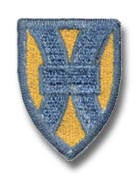| If you do
NOT see the Table of Contents frame to the left of this page, then
Click here to open 'USArmyGermany' frameset |
|||
|
General
Support Center, Germersheim |
|||
|
|
|||
|
|||
|
|
|||
| GSCG History | |||
| 19.. - 19.. | |||
|
|
|||
|
|
|||
|
|
|||
|
|
|||
| Newspaper articles | |||
| (Source: Town Crier (Karlsruhe MILCOM newspaper), July 16, 1993) | |||
| General Support
Center Germersheim -- 1951-1993. In the early summer of 1951, the Chief of Ordnance, European Theater, directed that a vehicle park be established for the purpose of handling World War II vehicles that became surplus to Army requirements. An old German training ground, located on the West bank of the Rhein at Germersheim, Germany, was chosen to establish this activity. On October 18, 1951, the Germersheim Ordnance Vehicle Park was formally established by order of the Chief of Ordnance. Between 1951 and 1979, various mission, organization and command changes have occurred. These changes, however, did not change the original mission of the Ordnance Vehicle Park, that is, to receive, store, maintain and issue major end items of equipment and general supplies in support of the US Army in Europe. On January 1, 1979, a significant change to the previous supply/storage mission was made. The commander and special staff of what was the Germersheim Reserve Storage Activity became part of the newly established Maintenance Activity Germersheim, an element of the 29th Area Support Group, Kaiserslautern. The previous mission stayed with the Reserve Storage Activity which was made a separate subordinate element of the 29th Area Support Group. The Maintenance Activity was established to perform the Theater Army Repair Program (TARP) through the use of specialized repair activities; to perform DS/GS maintenance on bridging equipment; and to operate the USAREUR Bridge Park. The headquarters of the activity with its staff elements was located at Germersheim. Subordinate elements were located at Kaiserslautern, Pirmasens and Schwetzingen. The last major reorganization in April 1982 established the General Support Center Germersheim. At that time, the Maintenance Activity was organized into its present General Support Center structure. The newly established center was given command and control of the Reserve Storage Activity, Germersheim, and gave up its maintenance elements in the Kaiserlautern area. Thus, the General Support Center was organized geographically in Germersheim, Pirmasens and Schwetzingen. The GSCG was completed by adding its own internal data processing (DPI M103) and by establishing a Supply Support Activity to support its many diverse orgizational elements. The next three years again saw a reorganization of GSCG. DPI M103 transferred to 5th Signal Command as part of the Army's Information Management realignment. Elements at Pirmasens, to include Corps support elements at Hanau and Schweinfurt, were transerred to General Support Center, Pirmasens. GSCG assumed the mission of Corps Reserve Storage Activities in the V and VII Corps areas. During the period 1982 - 1989, the following specialized supply functions were added to GSCG's basic mission: Storage of small arms to include repair, controlled cryptographic items, M1A1 classified armor; storage of track shoes, storage of aviation intensively managed items, and repair of M1 Main Battle Tank. Since 1985, the GSCG has been tasked with change and new missions. The Theater Army Repair Program (TARP) was changed to the Intermediate General Support Repair Program (GSRP). In 1988, the Intermediate General Support Repair and Return to User (IGS-GSRR) program was established to provide GS level support to DS units. GSCG accepted responsibility for light tracked vehicles. From 1989 until 1990, maintenance support to the Corps Reserve Storage Activities (V and VII Corps) was provided by mobile teams from the Germersheim Maintenance Center performing inspection and repair on site. Also in 1989, the Enclosed Dry Air Method (EDAM) storage system was implemented. From 1989 through 1991, the following projects were of specific importance to this organization: -- Support to Desert Shield and Desert Storm; -- Operation Provide Comfort to help the refugees in Southwest Asia; -- Execution of the Intermediate-Range Nuclear Forces Treaty that resulted in the removal of Pershing II units and their associated supplies and equipment; -- The Wartime Host Nation Support Program, where the US Army provides caretaker support to the American manufactured equipment owned by the German Army throughout Germany; -- The MILVAN Repair Project for Operation Metal Box, used to remove chemical ammunition from Germany to Johnston Island; -- The Foreign Military Sales Program; -- USAREUR Unit Retrograde and Conventional Forces Europe Treaty Limited Equipment reductions. |
|||
|
|
|||
| Related
Links
|
|||
